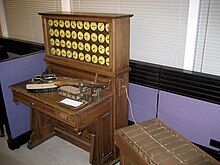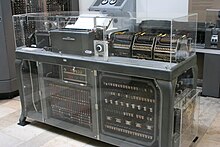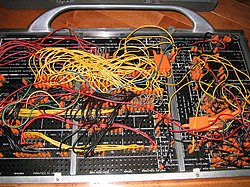Tabulating machine
The term "Super Computing" was used by the New York World newspaper in 1931 to refer to a large custom-built tabulator that IBM made for Columbia University.[2] Since the U.S. Constitution mandates a census every ten years to apportion both congressional representatives and direct taxes among the states, a combination of larger staff and faster-recording systems was required.Prior uses of machine-readable media had been for lists of instructions (not data) to drive programmed machines such as Jacquard looms.Clerks used keypunches to punch holes in the cards entering age, state of residence, gender, and other information from the returns.Since tabulator control panels were based on the machine cycle, both FARGO and RPG emulated the notion of the machine cycle and training material showed the control panel vs. programming language coding sheet relationships.On early models, the accumulator register dials would be read manually after a card run to get totals.With successive stages or cycles of punched-card processing, fairly complex calculations could be made if one had a sufficient set of equipment.It was developed by a team headed by J. R. Peirce and incorporated significant functions and features invented by A. W. Mills, F. J. Furman and E. J. Rabenda.Commonly called the 405 "tabulator," this machine remained the flagship of IBM's product line until after World War II.[17][18] The British at Hut 8 used Hollerith machinery to gain some knowledge of Known-plaintext attack cribs used by encrypted German messages.





electromechanicalpunched cardsHerman Hollerith1890 U.S. Censusaccountinginventory controlunit record equipmentSuper ComputingNew York WorldColumbia University1880 censusU.S. Constitutioncongressional representativesdirect taxesstatesconductorsrailway ticketprogrammed machinesJacquard loomssolenoidsmercuryrelay logickeypunchesinventorypunched card data processing equipmentcontrol panelamalgamated (via stock acquisition)Computing-Tabulating-Recording CompanyPowers Accounting Machine CompanyInternational Business MachinesIBM 407Remington Rand 409computersIBM 1401Plugboardfan-fold paperaccumulatorscarriage control tapeA. W. MillsKnown-plaintext attackIBM 402IBM 716IBM 700/7000 seriesIBM 1130IBM 421British Tabulating Machine CompanyPowers Accounting Machine Powers-Samas Accounting Machines LtdLeslie ComrieWallace John EckertJournal of the Royal Statistical SocietyTruesdell, Leon E.IBM and the Holocaust: The Strategic Alliance Between Nazi Germany and America's Most Powerful Corporation